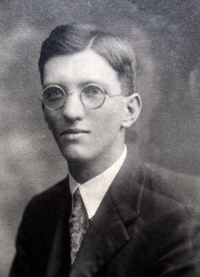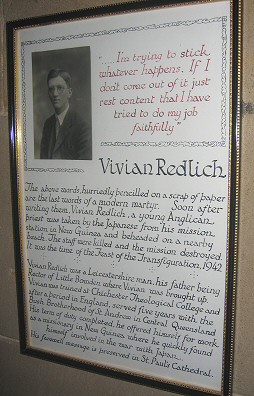 |
Vivian Redlich was a
pupil at St John's 1916-17. The son of a a vicar, he
became an Anglican priest, serving in New Guinea. For many years it was thought that he was among those known to have been executed by the Japanese when they invaded New Guinea. However information has come to light that it was not the Japanese soldiers who killed Vivian but members of the Orokaiva tribe with whom Vivian and the thirteen others in the missionary group had taken shelter. For further information please view the following links: An ABC interview on 22 Oct 2006: The transcript of an ABC News interview on Friday
21 Aug 2009 with Patrick Redlich, a fortnight before
a reconciliation ceremony was due to take place
in New Guinea. Ceremony of Reconciliation in Papua New Guinea,
report October 2, 2009 |
Some information on this
page, and the links provided (for which the editor has no
responsibility)
may still relate to the time when it was thought that the
Japanese had executed Vivian Redlich.
The fact remains that he was a priest and martyr.
Commemoration in Leicester Cathedral, St Martin of Tours - in 2004
"
... I'm trying to stick whatever happens. If I don't
come out of it, just rest content that I have tried
to do my job faithfully. "Vivian RedlichThe above words, hurriedly pencilled on a scrap of paper are the last words of a modern martyr. Soon after writing them, Vivian Redlich, a young Anglican priest was taken by the Japanese from his mission station in New Guinea and beheaded on a nearby beach. The staff were killed and the mission destroyed. It was the time of the Feast of the Transfiguration, 1942. Vivian Redlich was a Leicestershire man, his father being Rector of Little Bowden, where Vivian was brought up. Vivian was trained at Chichester Theological College and after a period in England, served five years with the Bush Brotherhood of St Andrew in Central Queensland. His tour of duty completed, he offered himself for work as a missionary in New Guinea, where he quickly found himself involved in the war with Japan. His farewell message is preserved in St Paul's Cathedral. |
 |


Vivian Frederick Barnes Redlich, Priest
Little Bowden
Chichester Theological College 1926. Deacon
1932; Priest 1933; diocese of Wakefield
Curate of Dewsbury Moor, 1932-35
Member of the Brush Brotherhood of St Andrew, Queensland, 1935. Priest-in-charge Dawson Valley, 1935-36, diocese of Rockhampton; Priest-in-charge, Winton, 1937-40. Diocese of New Guinea, 1940; Doguara, via Samuria, Papua; Priest-in-charge Sangara, Papua. Vivian was martyred in 1942.
In July 1942 after a short illness, Vivian returned from Doguara, the headquarters of the New Guinea Mission, to his Mission Station in Sangara, in Papua.
Japanese warships were already shelling the coast further South as he landed. On Saturday July 25th the travelling Medical Assistant of the Papuan Govt. arrived in the Sangara district, and, hearing that Vivian was in a shelter prpared for him by the natives, went to see him. This official was a Roman Catholic and was very friendly with Vivian and other members of the Anglican Mission in New Guinea. To him we are indebted for what details we have of Vivian's last few days. He found Vivian surrounded by church members of the district who were much alarmed by conditions in their neighbourhood.
Vivian said to them: "I am your missionary. I have come back to you to help you and I will remain with you as long as you will let me. Tomorrow is Sunday and I shall celebrate Holy Communion. I invite you to Communicate." Next day the Medical Assistant himself was present at the Celebration, though he did not communicate and was deeply impressed with the spirit of devotion of all who communicated.
On the following day, Monday July 27th, Vivian hastily wrote in pencil on a piece of paper the following message to his father, the Rev. Canon Edward B Redlich, Rector of Little Bowden: -
Somewhere in the Papuan Bush
July 27th 1942
My Dear Dad
The war has busted up here. I got back from Doguara and ran
right into it, and am now somewhere in my parish hoping to
carry on, tho' my people are horribly scared. No news of May,
and I am cut off from contacting her - my staff O.K. so far,
but in another spot.
I'm trying to stick whatever happens. If I don't come out of it, just rest content that I have tried to do my job faithfully. Last chance of getting word out: so forgive brevity.
God Bless you all,
Vivian
Vivian's fiancée May Hayman, an Australian nurse, was bayoneted to death by the invading Japanese army:
The New Guinea Martyrs (originally from St John's Cathedral, Brisbane) - 2004
"Twelve missionaries and church workers were killed by the invading Japanese in New Guinea in the Second World War. The four women in the group are commemorated in a window high up the east wall in the south transept of St John's Cathedral.
Lilla Lashmar and Mavis Parkinson were teachers and Margery Brenchley and May Hayman were nurses. Lilla and Margery were stationed at Sangara. They were rounded up by the Japanese with some of the men and were beheaded on Buna Beach in August 1942. Lilla Lashmar was originally from Kangaroo Island, South Australia, and trained as a teacher before responding to the call to missionary work. Margery Brenchley was born in England but came to Brisbane as a teenager. She trained as a nurse in Brisbane and went to New Guinea in 1927.
May Hayman and Mavis Parkinson were stationed at Gona and were captured by the Japanese after many difficult days in the jungle, trying to escape the patrols and were executed by the bayonet in late August 1942 at Jegerata.
May had worked as a nurse in various Australian hospitals and not long before her death had announced her engagement to the Reverend Vivian Redlich, another New Guinea martyr. He was with the Sangara group on Buna Beach. Mavis Parkinson grew up in Ipswich and was an old girl of Ipswich Girls' Grammar School. She trained as a teacher at the A.B.M. College before going to New Guinea.
All these women were devoted to their work with the New Guinea people and refused to leave them even at the risk of their own lives.
Prepared by Lesley Williams
August 2002"
Links
Team Parish of Market Harborough: St Nicholas, Little Bowden scroll of reconciliation sent from the diocese of Yokohama in 1992.
Leicester
Cathedral
Anglican Board of Mission: A resource book of the Martyrs of
Papua New Guinea and Melanesia
Australian War Memorial - May Hayman
Papua New Guinea showing Sangara (Wikipedia)
An account of the military situation in the area at the time
- Kokoda campaign (Wikipedia)
page last updated 9 Feb 14